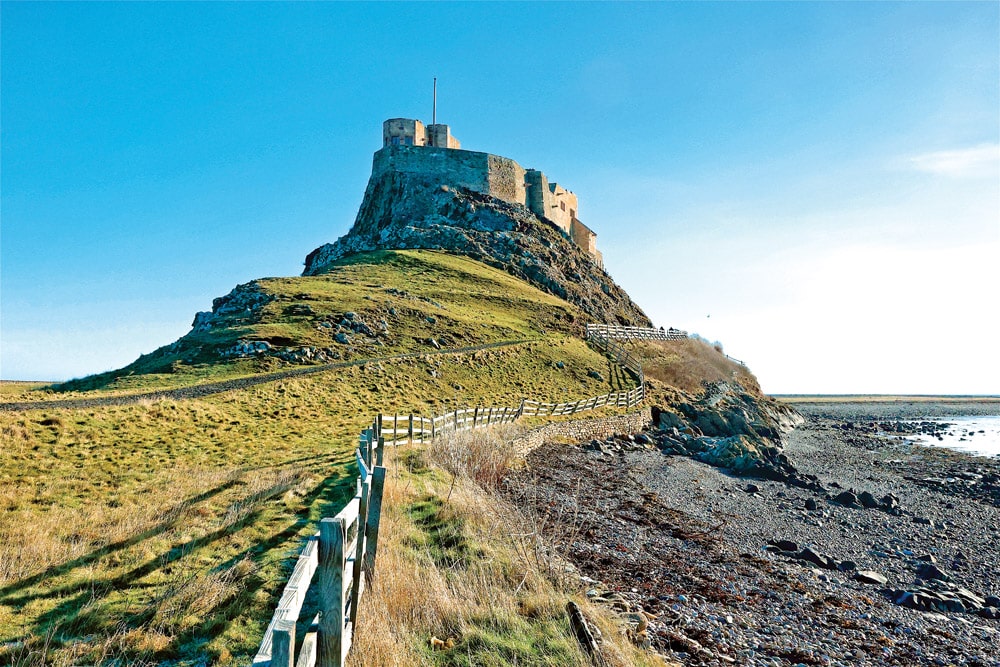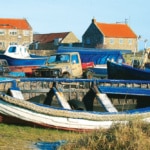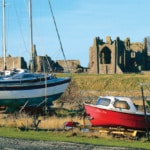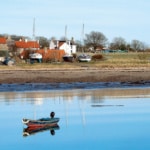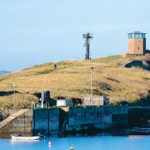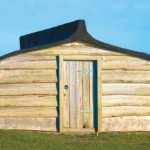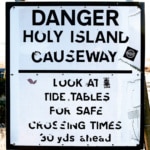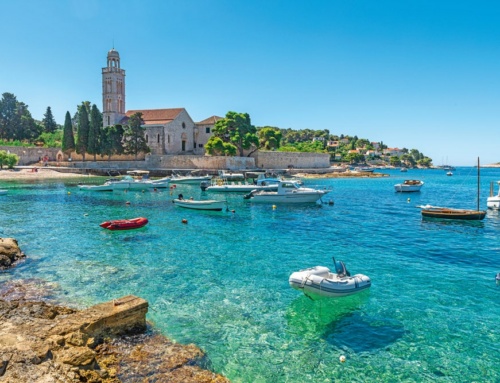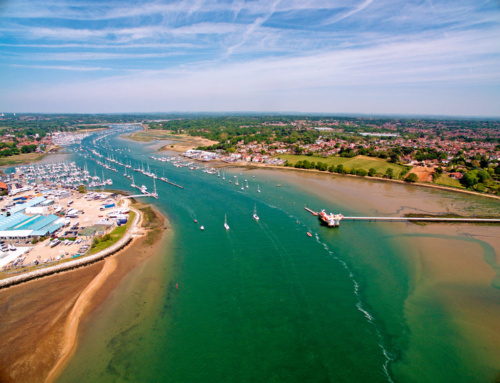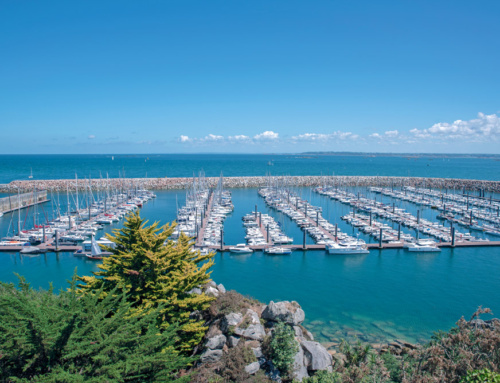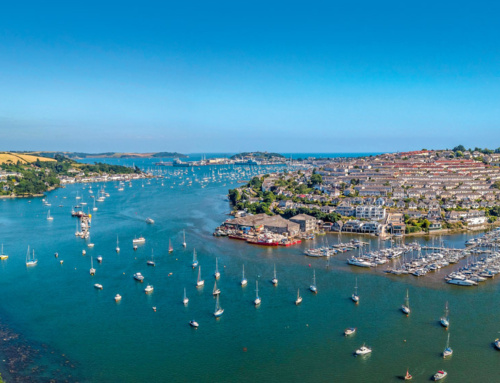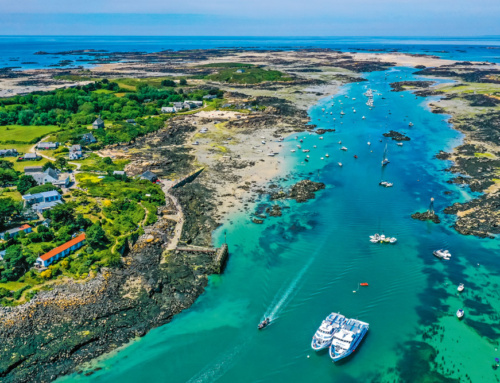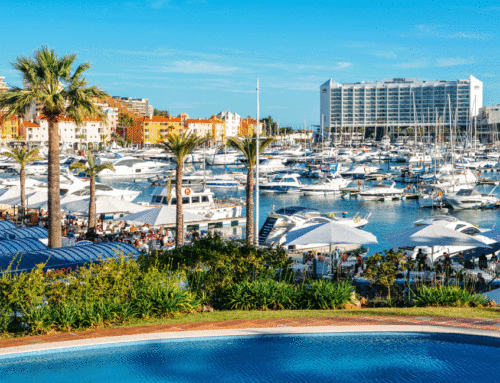Alex Whittaker guides us on a visit to the most mystical and alluring of all the Farne Islands …
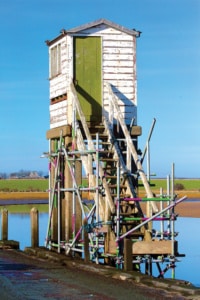
Weathered wooden refuge on the causeway.
Sacred Lindisfarne is famous for its superb position on the rugged Northumberland coast. It lies in a wonderfully romantic setting, with wide Northumberland skies, deserted strands and rocky coves. It is surrounded by strong tides, submerged reefs and rocks awash. Lindisfarne is often referred to locally as ‘Holy Island’. It is one of the Farne Islands, of which there are 15–20, depending on the state of the tide. These islands all lie within 4 miles of the mainland and are divided into two groups: the Inner Group and the Outer Group. Lindisfarne is famous for its long history stretching back before the Dark Ages – a span that included Christian saints, Viking invasions and the Norman Conquest. Over the centuries it has been the site of various military fortifications and religious settlements. Since the sixth century, Lindisfarne has been closely associated with the Christian saints Aidan and Cuthbert, and most notably the Venerable Bede. Furthermore, the Lindisfarne Gospels have long been acclaimed as the most spectacular manuscript to come down to us from Anglo-Saxon England. By Tudor times, the island was being used as a fort to store guns. Later, fishing, coal imports and lime exports all had their place. The latter even had a waggonway, traces of which can still be found around the village and harbour.
Approach from sea
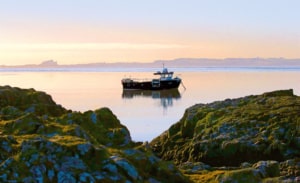
Looking from the sea wall over to Bamburgh Castle in the distance.
Day boating to Lindisfarne from nearby ports on the top of the tide is the preferred option. Lindisfarne is best thought of as a settled-weather, day-visit destination. Seahouses is the obvious local jumping-off point; however, you can actually day-boat from Lindisfarne Harbour, by prior arrangement with the harbour master. Pilotage in these waters is a serious matter. There are sweeping tides, sandbars, rocky needles and submerged ledges to navigate. Careful planning with close attention to the Admiralty Charts and your depth sounder is required. If you had the time, our advice would be to follow a local trip boat on a fine day to Lindisfarne out of Seahouses, entering all the key waypoints on your phone app. However, in brief: the Swedman Buoy will lead you on until you can spot the easterly cardinal buoy ‘Ridge’ Q(3)10s. This will be the start of your final approach to Lindisfarne Harbour.
From a point just south of this buoy, you should be able to identify the leading beacons on Guile Point at the north end of Old Law island. These stone obelisks are very conspicuous. They line up on 260° true, and one displays a sectored Oc.WRG.6s light. Vessels drawing up to 1.5m can enter Lindisfarne Harbour at all states of the tide. However, note that breaking seas can occur on the bar, especially in conditions of an onshore swell and low water. Following inwards leads you to the green conical Triton buoy on the starboard hand (Q.G).
This same leading line using the beacons on Old Law can be employed if approaching from the east-north-east after having rounded the Farne Islands by the seaward route. This leading line will also take you south of the dangers of Stiel Reef and the drying Goldstone. Approaching Lindisfarne from the north, it will be necessary to pass between the red can buoy Plough Seat (Q.R) and the green conical Goldstone (Q.G) to avoid the reef and the Plough Seat reef lying to the west. Thence, pick up the Easterly Cardinal Ridge Buoy and proceed. Whichever way you arrive at the green conical Triton Buoy (leaving it to starboard), it is then necessary to pick up a new transit between the large triangular beacon on Heugh Hill and the belfry of Holy Island Church. There is a drying wreck just to the north of this leading line as one approaches the deep-water pools. The tide can run very strongly in this close approach, maybe up to 4 knots. The deep-water pool has over 6 metres in hand. Smaller craft can anchor closer inshore, roughly to the south of the triangular beacon. You need the harbour master’s permission to moor or land. Modest fees are payable. The best advice is to speak to the harbour master first and visit Lindisfarne in settled weather.
Guile Point East and West
As previously mentioned, Guile Point East and Guile Point West are a pair of stone obelisks standing on a small tidal island on the side of the channel. The obelisks are leading marks, which, when aligned, indicate the safe channel over the bar from seaward. The beacons were established in 1826 by Newcastle-upon-Tyne Trinity House. Since the early 1990s, the sector light has been fixed about one-third of the way up Guile Point East.
Lantern Chapel
Heugh Hill is the low ridge on the southern edge of Lindisfarne. Heugh Hill Light is a metal framework tower with a black triangular daymark. Prior to this, a wooden beacon with a trianglular topmark had stood on Heugh Hill for decades. Nearby is the former coastguard station, recently refurbished and opened to the public as a viewing platform. An adjacent ruin is known as the Lantern Chapel. The origin of this building is lost in time, but it is possible it was an earlier navigation light on this hill. This is an unlit daymark for daylight maritime navigation. It is a white brick pyramid, 35 feet high. Built in 1810, it stands on Emmanuel Head, the north-eastern point of Lindisfarne. It is thought to be Britain’s earliest purpose-built navigational daymark
Lindisfarne by causeway
Visitors towing their powerboats across to Holy Island should pay close attention to the timetables prominently displayed at the ends of the causeway. These times are also posted where the Holy Island road leaves the A1 Great North Road at Beal. Conveniently for we trailer boaters, these times are available online here.
- The slipway looking over to Lindisfarne Castle.
- You are never far from history on Lindisfarne.
- Looking towards the village from the boatyard.
The causeway is generally open from about three hours after high tide until two hours before the next high tide. However, the best advice is to consult the local authority timetables as close as possible to your planned specific date. Also note that bad weather may alter access times. Crossing is a great experience, especially if you have just patiently waited for the tide to recede. In that case, your tow vehicle may be pushing a bit of water out of the way! You also have to stay between the wooden poles. There is a very interesting wooden refuge on the causeway, up an interesting but somewhat rickety-looking tower. In spring 2022 it was being repaired. Somehow it looks just right in weathered wood. Beware that it is surprisingly common for vehicles to get stranded on the causeway. The moral is: double-check your crossing times.
Lindisfarne village
The causeway leads you to the village past the vast car park. Any ticket bought here is valid right down the coast too. We paid by card at one of the machines towards the centre of the car park. Other machines by the gate invite you to pay cash or to download an app and use your phone, which proved less than convenient. The village is a honeypot for day trippers in the summer, but it has few facilities for boating folk. However, the harbour area, the long strand, the big Northumberland skies and the enigmatic castle are hugely atmospheric. The local ‘boatyard’ is a mellow jumble of old boats, lobster pots, ropes and wind-bent sheds. It’s a superb place to explore on foot; it just goes on and on. There are local fishing vessels working out of this harbour, but I was told that only about half a dozen are in serious employment. The target species appeared to be crab and lobster.
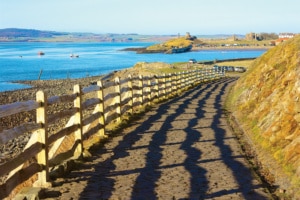
Looking down from the castle towards the harbour.
The harbour and the surrounding land are managed by the Holy Island of Lindisfarne Community Development Trust. The inner harbour, called ‘The Ouse’, has moorings for local boats, and also some for visiting vessels. The LCDT website says there is a limited amount of onshore space for boat storage, but the tone is welcoming. The public are cautioned that this is a busy ‘fishing harbour’ in regular commercial use by the fishing community. By arrangement, pleasure craft and canoes can be launched from the harbour. If the harbour master is not available, landing and harbour dues can be paid in the village at ‘The Lindisfarne Centre’. You can walk around the village in a few minutes.
Tide times
https://holy-island.com/holyislandharbour/
Contact info.
The harbour master is Paul Douglas and he can be contacted by email at:
The harbour master’s mobile phone number is 0754 8675505.
Fuel
There is no fuel available at Lindisfarne. Seahouses is the closest location.
Water, toilets and victualling
There is a water tap on the village green. Public toilets are available with cold-water washing sinks. The village post office offers newspapers, sweets, gifts and such like. Sadly, the old village shop, which was run by two very elderly ladies, has now closed.
Chandlery
Understandably, there is no chandlery on the island, with Seahouses down the coast providing the nearest opportunity.
Lindisfarne boat sheds
For many years, local fishermen have recycled old wooden herring boat hulls as storage sheds. No visit to Lindisfarne by boating folk like us could ignore these amazing examples of living history. You can see these intriguing upturned hulls in two locations around the island: by the harbour and up the steep castle hill. The vernacular examples in the harbour all look authentically assaulted by time and weather. The replicas at Lindisfarne Castle are more gentrified and pristine. I suppose there is some sort of message there.
- Harbour slipway.
- Recreated boat shed at Lindisfarne Castle.
- The weathering says it all.
Lindisfarne Priory
These impressively romantic ruins lie within sight of the harbour. Wonderfully wasted, these remnants really do project a sense of history, when the monastic life was considered highly desirable. Some of the remaining stonework is beautifully sculpted – great to experience at first light, or better yet, during a late sunset when you can imagine the Benedictine monks softly chanting their three psalms for Compline, the last order of the day. As previously mentioned, Lindisfarne is associated with Saints Aidan and Cuthbert, and the Venerable Bede. After Henry VIII’s dissolution of the monasteries, the site fell into disuse. The current site is administered by English Heritage, and there is an entrance fee. Note that toilets and parking are located in the village.
Lindisfarne Castle
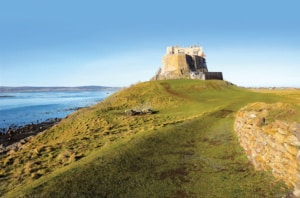
No cruise up this genuinely fascinating coast would be complete without a peek at Lindisfarne.
This remarkably impressive relic lies on Whinstone Hill, also known as Beblowe Craig. In some light, the castle can seem like a brooding presence, like something out of Kafka. In other lights, it looks like a stronghold from an ancient folk tale. There were earlier fortifications here, and then there was a royal fort built in Elizabethan times. The Tudors mainly used the island to store guns. However, the present building dates from the late Victorian era – in fact, from 1901, the year Her Majesty died. A rich entrepreneur, Edward Burgess Hudson, bought the castle in that year to be his residence. He engaged celebrated Victorian architect Sir Edwin Landseer Lutyens to remodel the castle. Close up and personal, the castle narrowly avoids looking like a folly. However, its stunning location makes you suspend disbelief. Today, the castle is administered by the National Trust, and you have to pay to enter the castle itself. It is normally open to visitors until 30th October (it is usually closed on Fridays). However, post-Covid, it is recommended to check times and pre-book your tickets: apparently they sell out very quickly. Check the NT website for up-to-date details at: https://www.nationaltrust.org.uk/lindisfarne-castle.
Also note that, if arriving by car with any crewmembers with restricted mobility, parking is 1 whole mile away, and access to the castle is via a steep path. Also note that there is no public toilet at the castle. Finally, you will probably need suitable footwear to tackle the hill to the castle in inclement weather. The rather tussocky grass battered my elderly Docksides. Nevertheless, the views from the top are exceptional.
Pubs, restaurants and hotels
If you can get a table in high season, Lindisfarne has a good reputation for food and drink. In fact, Tripadvisor has recorded no duffers. The Ship Inn pub has a very good reputation on Tripadvisor. The Pilgrims Coffee House has the best reputation for food, closely followed by The Crown and Anchor restaurant. The handsome Manor House Hotel Restaurant facing the water is also highly praised. The island can get very busy in summer, and it is usually better to book – if you can. There is also such a thing as Lindisfarne Mead made from honey. Apparently it was originally made by the ancient monks to fortify their souls during long cruel Northumbrian winters. It’s got to be worth a try …
Slipway
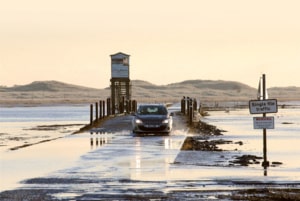 Lindisfarne has its own slipway, and there is limited space for trailer storage beyond. Access details and prices are available from the harbour master. Prices are very reasonable. Alternatively, launching from Seahouses is another good option.
Lindisfarne has its own slipway, and there is limited space for trailer storage beyond. Access details and prices are available from the harbour master. Prices are very reasonable. Alternatively, launching from Seahouses is another good option.
Wildlife
The Farne Islands as a whole are famous for their wildlife. These include Arctic terns, puffins, pale-bellied Brent goose, wigeon, teal, pintail, merlin, dunlin, bar-tailed godwit and grey seals. Local trip boats operate from Seahouses, which is handy if you are scouting summer locations for your trailer boat.
Charts
Admiralty 111, 1012
The verdict
Lindisfarne is an evocative location. It is one of those places that possesses real charm, even in this modern age. There is nowhere quite like it. The rest of the Farne Islands are on the doorstep, and the wildlife is spectacular. No cruise up this genuinely fascinating coast would be complete without a peek at Lindisfarne.
Ten interesting facts about Lindisfarne
- Lindisfarne Monastery was founded in 634.
- The attack on the monastery in 793 is now taken as the beginning of the Viking Age.
- Lindisfarne Island (Holy Isle) is 3 miles long and 1.5 miles wide.
- Lindisfarne Island has its own tidal causeway.
- On average, one vehicle a month is stranded on the causeway.
- The first castle was built on the island in 1550.
- Henry VIII ordered monasteries such as Lindisfarne Priory to be demolished.
- Lindisfarne Castle stands on Whinstone Hill/Beblowe Craig.
- Edward Burgess Hudson bought the castle in 1901 as his residence.
- The folk rock band Lindisfarne were originally called Brethren.

